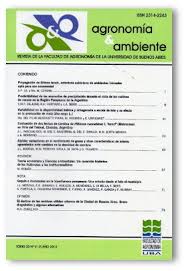View Item
- xmlui.general.dspace_homeCentros Regionales y EEAsCentro Regional Entre RíosEEA ParanáArtículos científicosxmlui.ArtifactBrowser.ItemViewer.trail
- DSpace Home
- Centros Regionales y EEAs
- Centro Regional Entre Ríos
- EEA Paraná
- Artículos científicos
- View Item
Ecuaciones alométricas de biomasa aérea para Prosopis nigra (Griseb.) Hieron. en bosques de Entre Ríos (Argentina)
Abstract
En un escenario de cambio climático global dado por el aumento de las emisiones de gases de efecto invernadero, la estimación del carbono almacenado en los ecosistemas forestales es fundamental y requiere herramientas precisas de predicción de la biomasa. Los objetivos de este trabajo fueron determinar la biomasa aérea y su distribución por compartimento en individuos de Prosopis nigra (Griseb.) Hieron. (algarrobo negro), estimar los factores de expansión
[ver mas...]
En un escenario de cambio climático global dado por el aumento de las emisiones de gases de efecto invernadero, la estimación del carbono almacenado en los ecosistemas forestales es fundamental y requiere herramientas precisas de predicción de la biomasa. Los objetivos de este trabajo fueron determinar la biomasa aérea y su distribución por compartimento en individuos de Prosopis nigra (Griseb.) Hieron. (algarrobo negro), estimar los factores de expansión de la biomasa (FEB) por clase diamétrica, y obtener ecuaciones alométricas de biomasa en bosques nativos del Espinal (Entre Ríos, Argentina). En 30 individuos de distintas clases diamétricas, se midieron variables dasométricas y se determinó la biomasa total (Bt) y por compartimento. Se evaluaron y ajustaron 8 modelos genéricos de frecuente utilización en especies leñosas perennes y, adicionalmente, se construyeron nuevos modelos, utilizando como variables predictoras a aquellas que demostraron una alta correlación con la biomasa. La bondad de ajuste de los modelos se evaluó mediante el coeficiente de determinación ajustado, error cuadrático medio de predicción, estadígrafo PRESS, Criterios de Información de Akaike y Bayesiano e Índice Furnival. El valor promedio de FEB fue 4,98. Resultaron de mejor ajuste aquellas ecuaciones que tuvieron como predictoras a la variable combinada que incluye el diámetro a la altura del pecho -DAP- y la altura -h- (DAP2*h), el diámetro basal (d30) y h. El DAP y d30 fueron incluidos como variables explicativas de la biomasa en las regresiones simples. Por su practicidad y operatividad se recomienda utilizar la función Ln (Bt) = -2,40 + 2,49*Ln (DAP). La comparación de estos modelos con otros desarrollados para P. nigra ratifica la importancia de generar funciones específicas para cada provincia fitogeográfica, a fin de brindar precisión a las estimaciones de biomasa y carbono.
[Cerrar]
In a global climate change scenario given by the increase of greenhouse gas emissions, forest ecosystems carbon storage estimations require precise tools for predicting biomass. The objectives of this study were to determine the aerial biomass and its distribution by compartment in Prosopis nigra (Griseb.) Hieron. (algarrobo negro) individuals, to estimate the biomass expansion factors (FEB) by diametric class, and to obtain allometric equations of
[ver mas...]
In a global climate change scenario given by the increase of greenhouse gas emissions, forest ecosystems carbon storage estimations require precise tools for predicting biomass. The objectives of this study were to determine the aerial biomass and its distribution by compartment in Prosopis nigra (Griseb.) Hieron. (algarrobo negro) individuals, to estimate the biomass expansion factors (FEB) by diametric class, and to obtain allometric equations of biomass, in native forests of the Espinal (Entre Ríos, Argentina). In 30 individuals of different diametric classes, dasometric variables were measured and the total biomass
(Bt) and by compartment were determined. Eight generic models of frequent use in woody perennial
species were evaluated and adjusted and, additionally, new models were created, using as predictive variables those that demonstrated high correlation with biomass. The goodness of fit of the models was assessed using the adjusted coefficient of determination, mean square prediction error, PRESS statistic, Akaike and Bayesian Information Criteria and Furnival Index. The mean value of FEB was 4.98. Those equations that had as predictors the combined variable diameter at breast height -DBH- and height -h-(DBH2*h), the basal diameter (d30) and h, were better adjusted. The DAP and d30 was included as explicative variables of biomass in simples regressions. Due to practicality and operation, the function Ln (Bt)= -2.40 + 2.49*Ln (DBH) is recommended. The comparison of these models with others developed for P. nigra ratifies the importance of generating specific functions for each phytogeographic province, to add precision to biomass and carbon estimates.
[Cerrar]

Author
Sione, Silvana María José;
Ledesma, Silvia Gabriela;
Rosenberger, Leandro Javier;
Oszust, José Daniel;
Andrade-Castañeda, Hernán J.;
Maciel, Gabriel Omar;
Wilson, Marcelo German;
Sasal, Maria Carolina;
Fuente
Agronomía&Ambiente. Revista de la Facultad de Agronomía UBA 40 (1) : 63-76. (2020)
Date
2020
Editorial
Facultad de Agronomía, Universidad de Buenos Aires
ISSN
2344-9039
2314-2243
2314-2243
Formato
pdf
Tipo de documento
artículo
Palabras Claves
Derechos de acceso
Abierto
 Excepto donde se diga explicitamente, este item se publica bajo la siguiente descripción: Creative Commons Attribution-NonCommercial-ShareAlike 2.5 Unported (CC BY-NC-SA 2.5)
Excepto donde se diga explicitamente, este item se publica bajo la siguiente descripción: Creative Commons Attribution-NonCommercial-ShareAlike 2.5 Unported (CC BY-NC-SA 2.5)


